by Chalerm Raksanti
Ladakh, the tiny country nestled behind the Himalayas,
is actually part of India, and for many years the Delhi government
declined to open the country to visitors because it was a military area
bordering on the Chinese People’s Republic. Now, of course, “Little
Tibet” as it is sometime referred to, is a household word for the
traveler who eschews ordinary tourist traps.
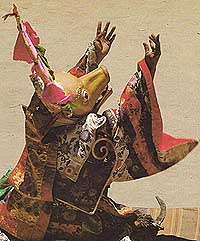 Scene
from the Mystery Play.
Scene
from the Mystery Play.
Ladakh is a blend of sandy deserts, fertile valleys and
high pastures far above the tree line. Villages of mud huts dot the
hillsides and oases of green amid the barren wilderness provide sanctuary
for its denizens. In this community of monks the rites of lamaistic
Buddhism are still preserved and immense monasteries house priceless
treasures which are faithfully reproduced in volume. Ladakh is synonymous
with peace and beauty. The people’s faces look as if nature has carved
them out of wood or stone. And one sees centuries-old caravan tracks in
the sand stretching as far as the eye can see; tracks at the foot of a
temple hewn out of the rock-face. Ladakh is watered by the River Indus on
its way down to the Punjab, and many a grain of sand in the Indian Ocean
may well have once formed part of a stone in the land behind the
Himalayas.
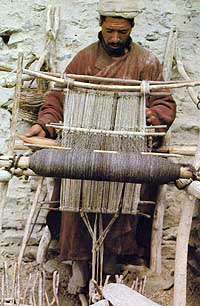 The
yak’s dung-colored yarn is woven by hand on this primitive loom.
The
yak’s dung-colored yarn is woven by hand on this primitive loom.
It is difficult to form an overall impression of the
Ladakhis simply by observing the numerous tribes that make up this
relatively small community. They are a peasant people, craftsmen, and
seasonal nomadic herders living at from 3,000 to 5000 meters above
sea-level in oases they have themselves created out of melting snow and
glaciers. They have evolved a complicated system of irrigation to water
their barren fields. Their houses are built of bricks made of dried clay
or dung, and they wear hand-woven clothes.
The shepherds in charge of thousands of animals deliver
butter, wool and other vital raw materials and the caravan leaders
constitute links between the uplands and the lowlands, between those who
keep themselves alive and those who keep others alive. The first settlers
were Tibetan nomads with sheep, goats and yaks. The next arrivals were the
Indian Buddhist missionaries who introduced red robes; their descendants
the Mon are now scattered all over Ladakh. After the Mon came the Dards
from the Muslim Hunza district.
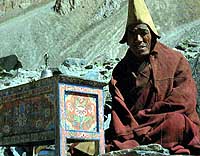 A
prayer leader from the Karcha Monastery seated behind a prayer table.
A
prayer leader from the Karcha Monastery seated behind a prayer table.
Ladakh is rich with all kinds of animals from
antelopes, snow leopards and wolves to the mighty Ovis Ammon, a wild sheep
with horns 1.3 meters long and 45 centimeters in diameter at the base. And
of course the yak is as indispensable to the Ladakhis as it is to the
Tibetans. For a long time nobody seemed to know what these shaggy beasts
with their long horns really were. Yaks are not found at altitudes below
3000 meters above sea-level. The yak is a curious mix of goat, horse and
ox and it is the greatest asset of the Himalayan peoples. Its bushy,
silvery white tail and its long black silken hair reaching to the ground
is spun into wool and woven into clothes. The yak gives milk, its dung is
used as building material, its flesh is edible and its horns are made into
drinking vessels. As a beast of burden the yak can keep a foothold on even
the steepest path and it can be ridden.
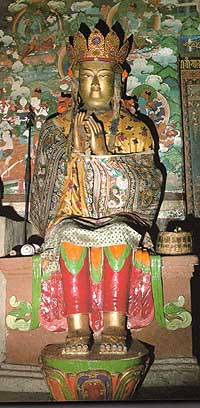 Golden
Buddha statue is draped with brocade and the crown is studded with large
precious stones.
Golden
Buddha statue is draped with brocade and the crown is studded with large
precious stones.
There are over 40 major monasteries in Ladakh, and 60
smaller ones. Every town or village has one. The chief monasteries are not
necessarily the largest or most beautiful. The Dali Lama of Tibet is their
living deity as in Tibet. And Ladakhis face Ladakh when they pray as
Muslims face Mecca.
The annual festivals are celebrated at the great
monasteries and the most lavish and spectacular of all is the Mystery Play
at Hemis, famous for its grotesque and elaborate costumes. It takes place
on the 6th month of the Tibetan calendar, June or July, and it celebrates
the birthday of the founder of the Tibetan form of Buddhism, Padme
Sambhava. The occasion is not purely a religious one. It is also a sort of
fair with booths and stands offering food and tea, jewelry and wood, and
stalls serving beer.
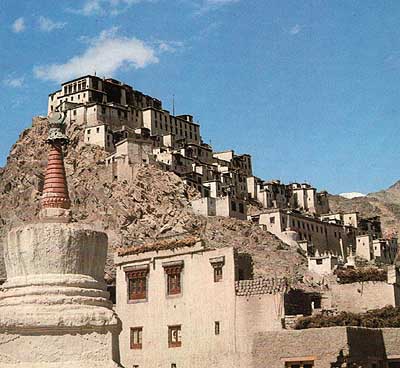
The
Tuktse Monastery.

 Scene
from the Mystery Play.
Scene
from the Mystery Play. The
yak’s dung-colored yarn is woven by hand on this primitive loom.
The
yak’s dung-colored yarn is woven by hand on this primitive loom. A
prayer leader from the Karcha Monastery seated behind a prayer table.
A
prayer leader from the Karcha Monastery seated behind a prayer table. Golden
Buddha statue is draped with brocade and the crown is studded with large
precious stones.
Golden
Buddha statue is draped with brocade and the crown is studded with large
precious stones.


